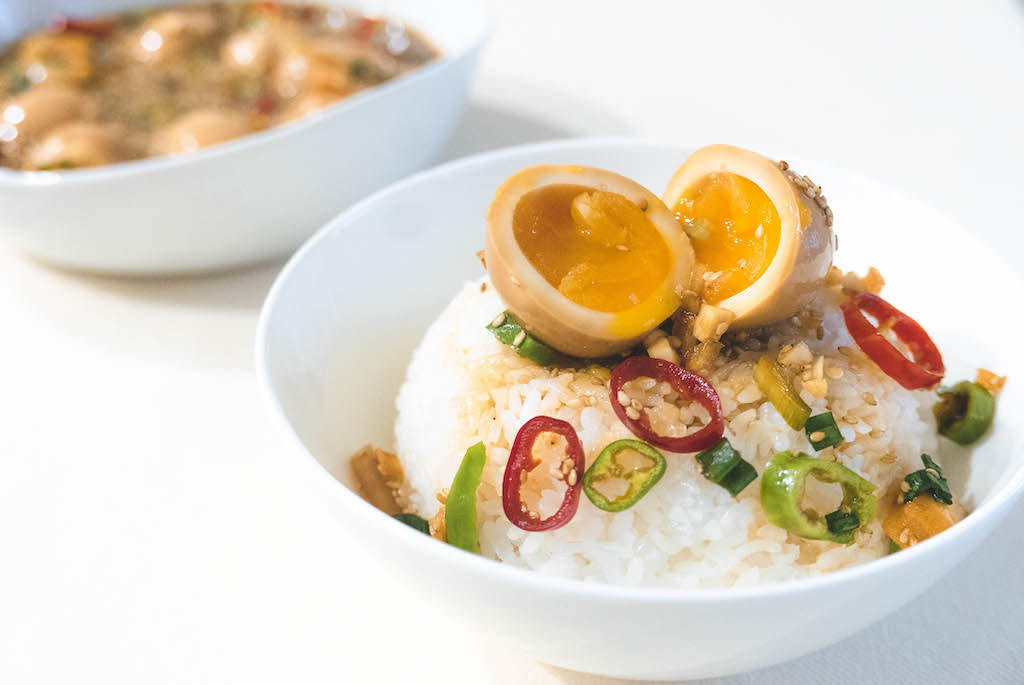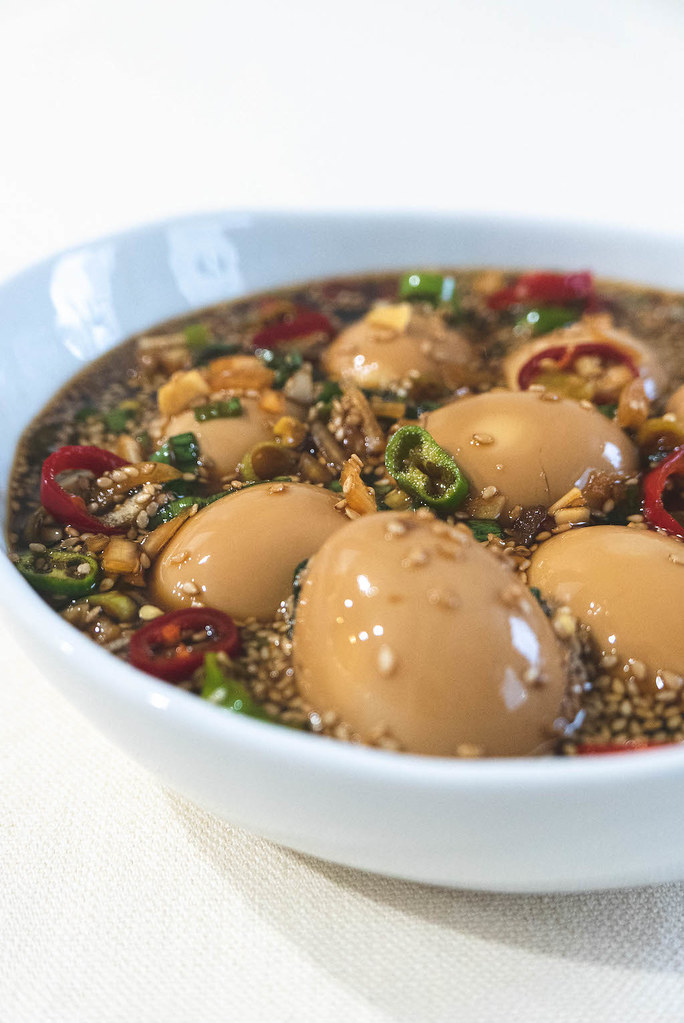In the late 2010s in South Korea, mayak eggs started trending as a delicious side dish to perfectly pair with both rice and noodles. While these Korean eggs need very few ingredients and take little effort to make, they burst with an insanely delicious flavor. As such, these eggs took the Korean food scene by storm.
So, what are mayak gyeran (마약계란), aka mayak eggs? Further, how do these Korean eggs taste?
What Does ‘Mayak’ Mean?
First, let’s define the meaning of mayak (마약). Well, to be blunt, the Korean word ‘mayak’ refers to illicit and illegal ‘drugs.’ On the other hand, gyeran (계란) means egg.
So, ‘mayak gyeran’ literally translates to ‘drug eggs.’ Before anything else, let me preface by saying there are no actual drugs in this dish. Instead, the name communicates how absurdly delicious and addictive these Korean eggs are to eat. Once you try this Korean banchan, you will continue to come back for more!
For reference, the younger generations often use the word mayak as slang to describe something crazy, gosh-darn delicious. Examples include this egg recipe, mayak toast (a recipe that blew up online after actress Jin Se-Yeon made it on the TV show Fun Restaurant), and mayak kimbap (check out recipes for this on the blogs Korean Bapsang or Seonkyoung Longest).

What Are Mayak Eggs (Mayak Gyeran)?
So, now that we know the meaning of the name, what exactly are mayak eggs?
Mayak eggs are a Korean banchan (side dish) you make by soaking soft boiled chicken eggs in a soy sauce-based marinade.
How Do You Make Mayak Eggs (Korean Marinated Eggs)?
To make these Korean marinated eggs, you need to first make the soy sauce marinating mixture. Typically, you make it using garlic, onion, green onion, red (hong) and green (green) gochu peppers, sesame seeds, a sweetener (examples include oligodang, honey, sugar, or mul-yeot syrup), kombu (dasima in Korean), soy sauce, and water.
Once you make your marinade, you need to boil your eggs!
Then, after boiling and peeling your eggs, place them in the marinade. These eggs need to sit overnight in the refrigerator to soak up the flavors of the marinade. You will note that the white eggs turn a brown color after marinating overnight!
For mayak gyeran, you typically soft boil the eggs. But, if you do not like soft-boiled, hard-boiled eggs are tasty as well. The soft boiled eggs make the dish creamy, jammy, and succulent. On the other hand, hard-boiled eggs have a firm texture and a milder flavor that balances well with the marinade. Though I prefer the soft boiled version, my husband prefers hard-boiled eggs. In the end, make the eggs in your preferred style. Both are yummy!

For those new to Korean cooking or Korean terms:
- Gochu refers to a type of Korean chili pepper. These peppers come in both red and green varieties.
- Oligodang refers to a type of sweet Korean cooking syrup made from different types of fruits and vegetables. Typically, it is considered a healthier alternative to rice and corn syrup.
- Mul-yeot refers to Korean syrup. If the syrup is clear, it is typically made from corn. If the syrup is brown, it is typically made from rice.
- Kombu (Dasima) refers to a type of kelp that people use to boil in soups, stews, sauces, etc. This kelp naturally contains the Japanese ‘umami’ flavor.
Although this recipe is simple, cooking and peeling eggs can be a pain. So, let’s learn how to successfully make a soft boiled egg.
How Do You Successfully Soft Boil and Peel an Egg?
For this Korean egg recipe, you need to successfully soft boil and peel eggs. Unfortunately, this can be difficult for two reasons. First, you need to balance the time between undercooking and overcooking the egg. Second, soft boiled eggs are notoriously harder to peel because they can burst open if you squeeze the egg too hard while peeling. I’m sorry, I know it is a pain!
So, let’s give some tips on how to peel the eggs more easily! Though we cannot promise that every single egg will peel perfectly, we can promise that the process will be easier than other options.
Then, we will teach you how to peel the egg so it doesn’t break open.

How to Soft Boil an Egg? Soft Boiled Egg Tips:
- Room temperature eggs: If possible, remove the eggs from the refrigerator approximately 30 minutes before cooking. Room temperature eggs help ensure that: 1) the eggs cook evenly in the water 2) the centers of the eggs maintain the creamy yolk while the whites completely cook, and 3) the eggs do not crack because of the rapid temperature change.
- Add vinegar and salt to the boiling water: Eggshells are made of calcium carbonate. Adding vinegar and salt to the water helps to break down some of the calcium carbonate, thus softening the shells and making them easier to peel.
- First, add the salt and vinegar to your pot of water. The pot needs to have enough water to fully submerge the eggs. Bring the water to a boil. Then, once boiling, lower the heat to a simmer and gently place each egg into the water. Cook your eggs on simmering heat for 6 minutes for large eggs. If you have a strong stove, such as a gas range, you may need to cook your eggs for 5 minutes. Each stove is unique and will cause your eggs to cook differently. If you want hard-boiled eggs, cook for 8 to 10 minutes.
- Lower the eggs into the water using a slotted spoon. That way, the eggs do not hit the sides or bottom of the pot and crack open. Also, the eggs won’t hit one another when you place them in the water.
- Prepare an ice bath to place your eggs after cooking. In a large bowl, prepare a mixture of ice and cold water. Once the eggs are done cooking, remove them one at a time using the slotted spoon and place them in the ice bath. Remember to completely submerge the eggs.

How to Peel An Egg? Egg Peeling Tips:
- Let your eggs sit in the ice bath for at least 15-20 minutes to completely cool. As the eggs cool in the ice bath, they contract away from the shell. This process makes it easier to peel the eggs.
- Start by cracking the bottom of the egg. Typically, the bottom contains a small air pocket that helps get you going on the peeling process. With soft boiled eggs, you need to tap your eggs more gently and move at a slower pace.
- Once you peel off the bottom, gently crack the sides and top of the egg. Then, slowly peel your egg. If it is giving you trouble, peel your egg submerged in the ice bath. For some reason, though it is cold, this helps the process!
Frequently Asked Mayak Eggs Questions:
How Long Do Mayak Eggs Last in the Refrigerator?
Typically, mayak eggs (mayak gyeran) can be kept in the refrigerator for 3-4 days. If you plan on keeping them that long, remember the eggs need to remain fully submerged in the marinade. Otherwise, peeled eggs keep in the refrigerator for 1-2 days.
Honestly, in our house, the eggs never make it past day two!
What Should I Do With the Leftover Marinade?
Once you eat all of your Korean marinated eggs, what can you do with the leftovers?
In our family, we use the leftover marinade as a sauce on or in dishes. For example, we made fried chicken and then used the sauce as a dipping sauce. We also recommend reducing the marinade and using it as a brush-on sauce for cod or other types of fish or as the base for a stir fry!
Honestly, this yummy marinade tastes delicious on a lot of different foods.
Though you can repurpose the marinade after you eat the eggs, remember to cook with and eat it within a few days. Eggs, which are a perishable item, sat in the marinade for a long time.

How Do You Serve Mayak Eggs?
On one hand, you can keep your meal simple by serving mayak eggs on top of freshly steamed short-grained rice.
On the other hand, you can serve the mayak eggs as a side dish along with other Korean dishes. We love eating these Korean marinated eggs with kimchi fried rice. The flavors go really well together. Another delicious option is eating the eggs on top of different types of noodles.
These eggs are versatile and can go well with many different types of meals. So, don’t limit yourself!
We Hope You Enjoy Our Korean Mayak Eggs Recipe!
In the end, did you enjoy our Korean marinated eggs (mayak eggs) recipe? If so, we would love to hear about it in the comment section below!
Other Korean Recipes You May Enjoy:
- Korean Triangle Kimbap
- Korean Tuna Mayo Rice
- Romaine Sangchu Geotjeori (Korean Lettuce Salad)
- Maneul Jangajji (Korean Pickled Garlic)
- Gyeranjjim (Korean Steamed Eggs)
- Korean Barbecue Dipping Sauces
- Dalgona Coffee
In the end, if you have any questions or comments, you can also email us at [email protected]. And, finally, we would love to hear from you through our social media as well! You can follow us at @carvingajourney on Instagram, Twitter, Facebook, and Pinterest. Or, if you would like more articles like these, you can subscribe to our blog by joining our mailing list. We hope you enjoy our mayak eggs (Korean marinated eggs) recipe! Thank you so much for stopping by!
Carving A Journey is a participant in the Amazon Services LLC Associates Program, an affiliate advertising program designed to provide a means for sites to earn advertising fees by advertising and linking to Amazon.com. Although we may earn commissions for our endorsement, recommendation, testimonial, and/or link to any products or services from this website, these opinions are my own and I fully support these products.



